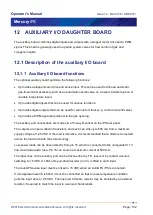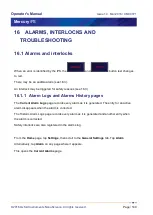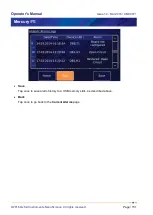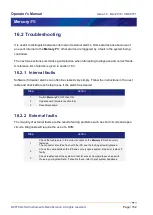
Operator's Manual
Issue 14
/
Mar 2016 / UMC0071
Mercury
iPS
©2016 Oxford Instruments NanoScience. All rights reserved.
Page
139
The heater connections on pins 6 and 7 and heater output filter are identical to the Temperature
Sensor board. The filter consists of a Common Mode Choke (L2) capacitors and 48v back to
back zener diodes to GND_CHASSIS and ferrite beads. The purpose is to comfortably exceed
EMC emission specifications and give a low-noise heater output.
The pressure transducer interface pins 1,2,4 and 5 are filtered with ferrite beads and r/c filters.
A 100Ω 0.05% resistor, R187, is fitted to measure 4-20mA output transducers. Standard 4-wire
connections are made to this resistor to eliminate cable and connector resistances from the
measurement, for optimum accuracy.
Capacitor C410 provided an AC connection between GND_CHASSIS and isolated transducer
interface ground GND_A, for noise reduction.
The measurement circuit operation depends on the type of pressure sensor used.
1
Absolute Current
sensors typically provide a 4-20mA output. This is passed through the
on-board precision 100Ω resistor; the voltage across this resistor is applied giving 0.4V to
2.0V referenced to Excite- across the and Sensor- inputs. This results in 80mV to
400mV between AIN1 and AIN2 of the ADC. The measurement is then made in a similar
way to the Absolute Voltage case described more fully below. The card passes the Current
reading in mA to the system, which uses the Transducer Calibration Table to determine the
pressure reading.
2
Absolute Voltage
sensors give outputs normally 0-5V or 0-10V referenced to
Excite- (-5V for 10V excitation or -7.5V for 15V excitation) tied to the Sensor- input. The
inputs pass through the analog multiplexer (U32) to the Buffer Attenuator, resulting in
approximately 0-2V or 0-1V between AIN1-AIN2 of the ADC(U12), offset so both inputs are
within the 0-5V range of the ADC. The ADC measures AIN1-AIN2 differentially against the
precision 2.5V reference (U17). The ADC has an internal programmable gain amplifier
(PGA) with fixed gains of 1,8,16,32,64,128. The firmware selects the correct gain to auto-
range the input for maximum precision over several cycles. The ADC has variable length
and selectable type of filters so that maximum accuracy is achievable in the available time.
This circuit can make readings at variable rates from 1Hz to 10Hz as required by the system
settings. The card passes a voltage reading to the system, which used the Transducer
Calibration Table to determine the pressure reading. The circuit is pre-calibrated to improve
accuracy, as explained below.






























